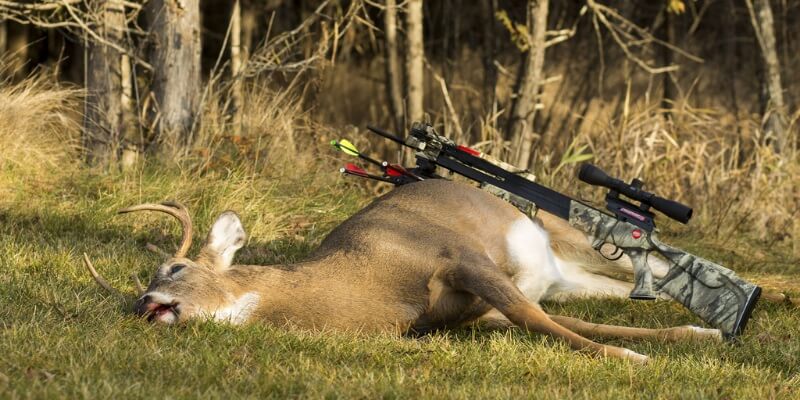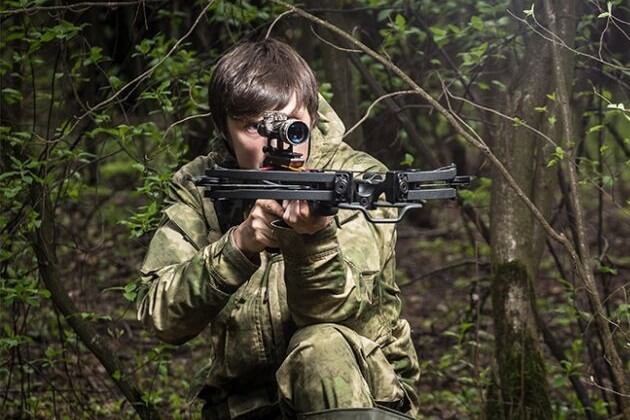
In recent years, the popularity of deer hunting with a crossbow has surged among hunting enthusiasts and communities. This method offers a distinct and contrasting experience compared to traditional rifle hunting.
However, successful deer hunting with a crossbow demands a significant amount of practice and knowledge. Precision is key when aiming for specific areas to ethically and responsibly take down the prey. In this article, I will share 12 tips and tricks, along with valuable information, to enhance your deer hunting experience with a crossbow, ensuring that you can use this tool effectively.
Deer Hunting Tips with a Crossbow
Let’s see my 12 pro tips about deer hunting with a crossbow step by step…
1. Understand the Crossbow Arrows
Choosing the right arrows is important to get group shots and the right crossbow arrow is an essential factor when it is going to hit the large deer. If the arrow is not well-balanced, the point of impact may vary from 2 to 12 inches at a distance of 30 meters.
You should know that for a crossbow of 50 cm, it will take about 25 cm more than the length of the crossbow is an arrow of 75 cm. I have tested 20 carbon arrows and all of them had tube warpages ranging from 0.001 to 0.010 inches. This irregularity will modify the point of impact.
You have to assemble your own combination of arrows and broadheads yourself. It doesn’t matter whether fixed or retractable (Both types have advantages and disadvantages), broadheads with 2, 3, or 4 blades do not have the same point of impact as practice tips. Broken or warped feathers cause the point of impact to change from 3/4 to 2 inches at 30 meters.
Also, the weight of the arrows varies with the point of impact. A broadhead arrow requires 16 times less energy to knock a deer down because it works by slicing through flesh, blood vessels and organs.
2. Set Up the Crossbow Scope the Right Way
A crossbow reticle scope makes it possible to carry out more precise sights by single or multiple crossed wires drawing a mark that allows alignments. There are 2 types of crossbow scope, either fixed power or variable power:
The sight of crossbow scope is mounted with horizontal lines, dots, small circles, or small triangles. It will be used as a reference to the point of impact depending on the shooting distance.
In the case of a variable power sight, the height of the bars changes with the power transmitted to the arrow. So, if your central reticle is adjusted for shooting at 15m, it is necessary to validate how far bars 1, 2 and 3 compensate to hit the target at 20, 25 and 30m.
- RECOMMEND TO READ: Best crossbow scopes for the money
3. Stand Yourself in a Proper Place
In most cases, hunting tracks the deer’s movement by using trail camera or rub lines that indicate where deer are traveling. But whitetails’ movement is unpredictable from any direction while they are running. To overcome this problem, most of the hunters stand a tad, either left or right position which ensures more freedom to swing the bow. Smart treestand placement improves your comfort level. It is a little bit critical when hunting with a crossbow because of its width, length and weight.
4. Shooting Practice 20 to 30 Meters
The typical hunting arrow follows this direction. This curve must intercept the channel of the deer’s vital zone. For example, a 400-grain arrow starts its course at a speed of 350 feet per second.
Make sure that the flight of the arrow remains in the vital zone without correcting the aim. It will be necessary to shoot at a maximum distance of 26 meters to kill a deer. The maximum reasonable distance with which an accurate and lethal shot can be performed is approximately 30 meters.

Unexpected movement of the deer, shooting angle, trembling or nervous release, and poor evaluation of the distance, are some examples among many which can make you miss your shot. The flight of an arrow bends much faster than that of a gun projectile, so every meter of distance makes a difference in crossbow shooting and the use of the rangefinder is paramount.
5. Shoot the Right Point
An improperly placed arrow from a crossbow may lack the lethality required for a quick and humane kill due to the lower energy and mode of action of crossbow arrows. Consequently, it is futile to target areas other than the vital zone when shooting at a deer.
Also, consider that a major part of this spongy heart-liver-lung area is protected by the rigid ribs (rib cage). The arrow must therefore have good energy to cross this natural barrier. As I previously said, make sure to shoot when you are close to the game within 30 meters.
6. Understand the Behavior in the Wind
A wind that arises about halfway along the flight path (14 m) has little effect on the grouping and hardly any on the point of impact because the arrow in flight is already stabilized. However, the same wind acting 4.5 m from the shooter has a detrimental effect on the point of impact and the grouping.
The group can widen by 1 or 2 meters! And above all, the groups of arrows in the same flight presented impressive dispersions sometimes approaching 2.5 meters! Therefore, it is crucial to possess the skill of “reading” the wind to effectively compensate for its impact. This can be achieved by adjusting the turrets of the telescopic sight or by off-centering the aiming point.
7. Deer Reaction (Sound Level)
The call of a female deer typically reaches a loudness of approximately 60 decibels. In contrast, crossbows produce a firing sound averaging around 90 decibels. Even though crossbows often incorporate noise reduction systems to dampen these effects, hunters need to be aware that the discharge of a crossbow can still generate a noticeable level of noise.

The crossbow is designed for short-distance and low-speed shooting compared to shooting with a firearm. It is obvious that the game hears the release, including the ultra-high frequency vibrations, and tries to flee.
The swiftness of white-tailed deer enables them to evade quickly, especially when a shot is fired from less than 30 meters. Unlike moose, they are more reactive to close-range shots. The challenge lies in finding a solution since firing from a greater distance to muffle the noise is not feasible; the required distance would be impractically large to deceive the vigilant deer.
The speed of the arrow is hardly modifiable and cannot be increased to reach that of sound, which exceeds 1050 feet per second. On the contrary, it is necessary to get closer to the deer to reduce the time interval between the arrival of the sound in its ear and the impact of the arrow on the beast.
If this interval is less than four times faster than that of humans (the animal’s reflex time), your chances of reaching the vital zone increase. However, the penetration and direction of the arrow at more than 30 meters may simply injure the animal due to a lack of kinetic energy.
8. Choice of Camouflage
The outfitter also offers the possibility of enjoying an exclusive territory in self-guided mode. Your camouflage hunting outfit will be based on the type of animal you are hunting. To hunt deer and other big game, be aware that these animals have difficulty distinguishing specific colors. Longer wavelengths such as orange, yellow, red, and pink are less likely to be detected. But, go for an outfit that breaks your figure and helps you blend in with the scenery. It is also necessary for your safety.
It is even more necessary so that certain animals do not detect your silhouette and your movement. A camouflage outfit with fluorescent colors also facilitates your shots.
9. Make Sure You’re Always Safe
- Hunting is not a risk-free activity, you have to think about your safety above all
- You must have to wear suitable clothes
- Test the cracks, and the color changes on your branches and improve the weakness
- Check the width of the axle to axle of your crossbow without tension to validate the safety space in your caches;
- Tighten all screws and seal the screw head properly
- If your crossbow is not fitted with a finger protector, use extra caution when pulling
- Keep the fingers of the supporting hand under the crossbow
- Confirm the warping of your arrows by rolling them on a flat surface
- Ideally, align your fixed broadheads with your feathers
- Check that the notch is 90 degrees with the rooster feather
- Always check that your arrow hits the string before shooting to avoid making an empty shot
- Check the arrow for cracks
- Maintain social connectivity
- And stay hydrate
10. Essential Accessories for Deer Hunting
- Rangefinder or binoculars
- Rigid and flexible carrying case
- Quiver
- 6-10 identical arrows (length, size, weight)
- 6-10 identical hunting blades (fixed or retractable)
- 6-10 practice points of the same weight as your broadheads
- Rope wax
- Lubricant for bridge
- Hexagon wrench
- Spare rope already stretched
- Rope tensioner (stretching system)
- Extension cord
- Boom puller
- Accessory (key) to change tips
- Lens cleaner and wipe
- Battery for crossbow scope, rangefinder or binoculars
- High-density styrofoam practice block
- Surveyor’s tape (biodegradable if possible)
- Survival knife
- Disarmament arrow
- Right bow hunting backpack
11. Access to a Bloodhound
Sometimes it is necessary to call in a bloodhound to locate the injured game, especially if the visual clues are nonexistent or difficult to interpret. From an ethical point of view and for your recovery, the bloodhound is an essential part of the search for a game injured (fatally). In addition, for a negligible amount of money, you will save a hunting party that costs you a lot more.
12. Maintain Your Crossbow
There are several advantages to maintaining your crossbow: first, it makes your shooting weapon more efficient, and second, the shooting accuracy will always be there and you are less likely to have to deal with shooting incidents. However, the maintenance of a crossbow is not cookie-cutter; you have to follow certain steps.
- Start by checking your shooting rope
- Check the condition of your crossbow pulleys
- Control the body of your crossbow
Conclusion
With over 6 years of experience in hunting reporting which includes visits to numerous hunting locations and interactions with passionate hunters, I saw that crossbows perform well with arrows of equal weight and at close range, up to 30 meters. As already said, for distances greater than 30 meters, the use of a rangefinder or binoculars is essential. I have observed a notable increase in the risk of injuring the animal due to the unpredictable impact of wind, affecting arrow trajectories at various weights.
When practicing shooting in the living area, always shoot with the same arrows that you will be using when hunting, wearing your hunting. The success of deer hunting relies heavily on consistent practice at various distances and under diverse climatic conditions.
Each year, thousands of crossbow hunters roam the deer hunting grounds to harvest their animals at the start of the hunting season. Especially since this is the best time of year, depending on the area. For more information about crossbow hunting, you can check my other articles.
Thanks for reading!
If you have any questions about deer hunting, leave a comment below and I will answer them.